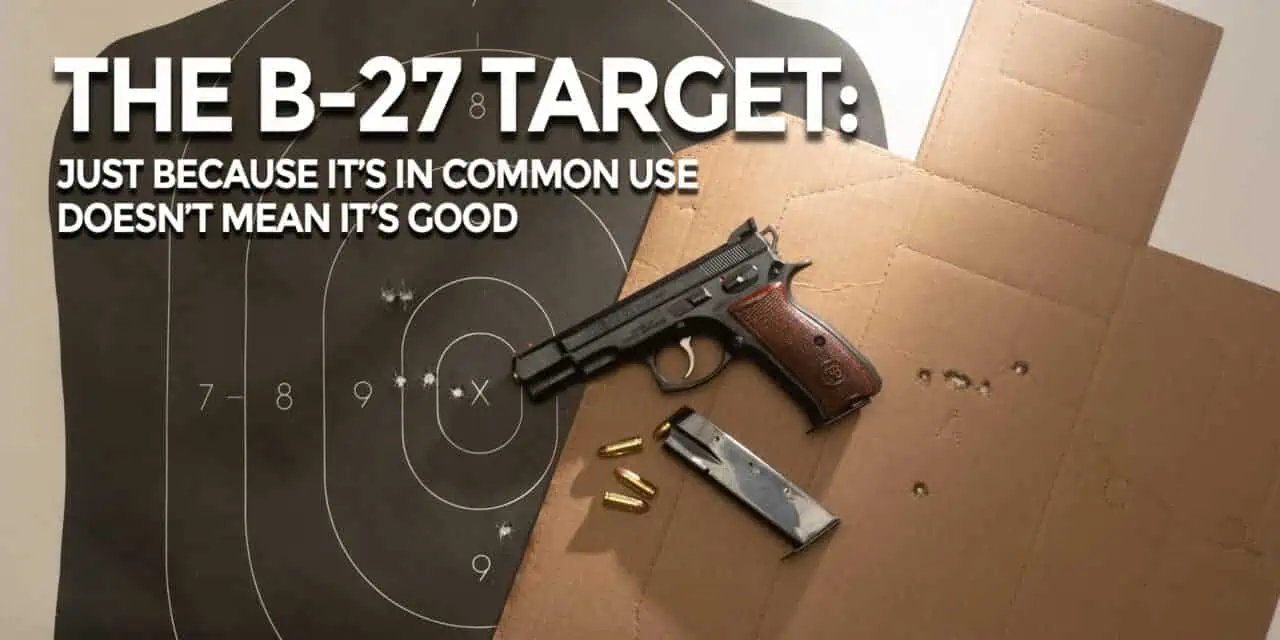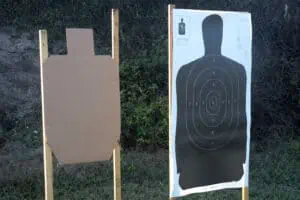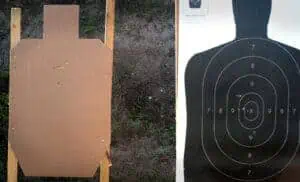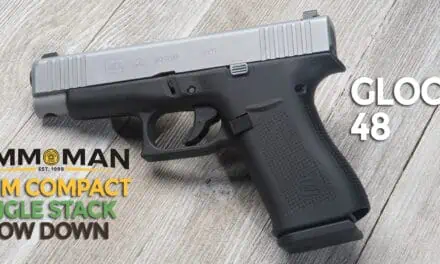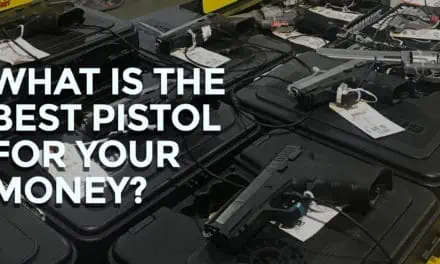The B-27 Target: Commonly Seen, But Is It Any Good?
Walk into any gun range and the chances are good you’ll see a variety of targets available to shoot. Many are vaguely human-shaped targets designed to hone your defensive marksmanship skills. One target in particular shows up in almost every range I’ve been to: the classic NRA B-27 silhouette target.
You’d think that such a ubiquitous target would be the last word in self-defensive pistol targets, right? I mean, if everyone uses it on their shooting ranges, it has to be a good target, right?
Wrong. In fact, the B-27 target is probably one of the worst targets out there for learning how to use a pistol. It’s a target that was created to serve the needs of one specific type of law-enforcement shooting competition. It has since spread across the country like an invasive species, popping up in all sorts of places where it is not really useful.
Make Your Shots Count
You may occasionally hear someone talk about the “man-stopping power” of the .45ACP round or some other type of ammunition. However, history has shown us that a pistol shot is usually not enough to stop a determined attacker. On top of this, there are only two areas on the human body that contain the vital parts that make us get up and go. They are the small region in the center of your face roughly between your eyebrows and the end of your nose, and an eight inch circle in the center of your chest where your heart and lungs are contained.
The bones in your nasal passages and around your eyes are less dense than other areas of your skull. A hit in that region has a very good chance of going all the way through the head and impacting the medulla oblongata. This is the part of the body that connects the brain to the spinal cord. Hit that, and the odds are good that the fight ends right there.
The second area, the eight inch circle in the chest, is easier to hit, but the effects of a hit in this area are less instantaneous. The body relies on a fresh supply of oxygen to survive. Shutting down the pump that supplies it (the heart) or the source of the oxygen (the lungs) will bring everything to a halt. The more bullets that impact in this region, the better your chances of stopping an attack. As noted firearms trainer Tom Givens says (more on him later), “What does someone who’s shot below the diaphragm do after they’ve been shot? The same thing they were doing before they were shot!”
We now know that we need to aim for the upper chest region on a human-shaped silhouette. Let’s now talk about why the B-27 has its highest-scoring zones in the stomach area, not the upper chest area.
A History of the B-27 Target
I reached out to two well-respected firearms trainers, Karl Rehn and Tom Givens, to find out more about the B-27 target and how it came to be so widespread.
Karl Rehn is a USPSA Grandmaster and accomplished firearms trainer. He runs KR Training in Texas and is an authority on the history of pistol training in the United States. According to Karl,
“The B-27 target is probably the most widely-used target today, but more modern targets, like the target used in IDPA competitions have a hit zone that is more anatomically correct. The ‘Down Zero’ on an IDPA target is right about where the vitals are on a normal human. On a B-27, however, you need to aim for the upper number 9 on the target to hit the important parts of an adversary. The target is also larger than a normal person. The target is around 23 inches wide. This is based on the frame of the target holder on most law enforcement ranges, not on real life. An 18 inch wide target is much more preferable, as that’s closer to the size of an average human torso.”
Tom Givens Weighs In On The B-27 Target
Tom Givens of Rangemaster Training is one of the most influential firearms trainers in business today. He is also the creator and host of the annual Rangemaster Tactical Conference. This event has firearms trainers from around the country meet to exchange ideas and learn from each other.
“The original silhouette target that the NRA later designated as the B-21 was originally called the ‘Colt Police Silhouette Target’. It was the first modern silhouette target to my knowledge, and was introduced about 1920 by Colt.”
“At the time, Colt dominated police and military handgun sales, and part of their sales strategy was to send experts like J. Henry Fitzgerald (Fitz) to police departments and help them set up training programs with their new target and Colt handguns. This target is a 1:1 scale representation of a 6 foot tall, 180 pound man drawing a handgun. The vital zone was shaped somewhat like a coke bottle.”
“As soon as NRA police competitions got started, everyone was shooting perfect scores on this target. First, they added a 6” X-ring in the chest of the target, to break ties (B-21X). Soon, folks were shooting too well for that. In 1962 the “Prehle” target used the Colt figure, but superimposed the scoring rings from the International Rapid Fire target. The rings were larger than the Colt silhouette, so the body of the target was enlarged to contain the 7-10 rings. Thus was born the B-27. The NRA is now starting to promote ‘tactical’ shooting competition for law enforcement. They have a new target for this, to replace the B-27. This is the new EIC target.”
Developing Effective Habits Starts Now
Learning where to place your hits where they matter the most, when it matters the most, is a vital skill for the defensive shooter. Even though it’s been around for a long time, the B-27 target doesn’t teach you to shoot at the vital areas of an attacker. Rather, the B-27 rewards shooters who aim lower than where an attacker’s vitals reside.
Realistically, we are not going to rise to the occasion in a life or death situation. Rather, we are going to fall back on our lowest level of training. Training to place our hits outside of the vital areas of an attacker increases our risk of failing to stop our attacker when lives are on the line. If the concealed carry test in your state requires a B-27, or your department uses it as a standard target, then by all means, use the target for those purposes. However, if you have a choice, choose a target like the USPSA target, IDPA Target, or another NRA silhouette target. Shooting at these targets will help to teach you better shot placement.

